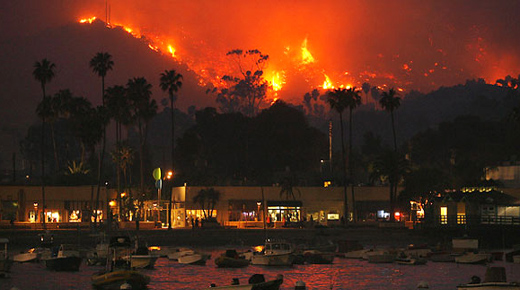
LOS ANGELES – As California continues to endure historic drought conditions, this and strong Santa Ana winds are two factors contributing to vicious and more frequent wildfires. Dry conditions are expected to continue this week, and in the southern part of the state, the National Weather Service has predicted conditions that will cause fires to quickly grow out of control. One such brushfire occurred on Apr. 18, forcing mandatory evacuations near LA and having scorched 1,020 acres by Apr. 20, when it was 55 percent contained. And the worst, experts say, could be yet to come.
The Apr. 18 incident was the result of an unattended cooking fire, and was, of course, exacerbated by the arid conditions, growing from 30 to 175 acres in just three hours. Even as evacuation orders have been lifted and the wildfire is now 60 percent contained, heavy, low-lying smoke is still expected to cling to surrounding areas throughout the early part of this week, causing potential visibility and breathing issues on roadways, according to CalFire. Fires like this are a problem, said meteorologist Brett Rathbun, who remarked, “The excessive drought across California can cause fires to spark even easier because the ground is so dry and lacks moisture.”
“We don’t know when the drought will end,” said Felicia Marcus, chair of the California State Water Resources Control Board. “Californians need to step up. We don’t even know if it will rain much in the next year.” After four years of steadily worsening drought, as climate change continues to rear its ugly head, it’s time for Californians to “make real lifestyle changes,” which means, above all, adhering to water restrictions. But even such measures won’t stop the problem of wildfires, especially if conditions continue to become drier.
And according to Benjamin Cook, a climatologist at the NASA Goddard Institute for Space Studies in New York, that’s exactly what’s going to happen. He said, “Climate change is going to lead to overall much drier conditions toward the end of the 21st century than anything we’ve seen in probably the last 1,000 years.”
And rain won’t save us, added Noah Diffenbaugh, a climatologist at Stanford University in Palo Alto, Calif. That’s because the hotter weather means whatever water falls to the ground is going to evaporate that much more quickly. “We’re on the cusp in California of having every year be a warm year, which means that when low precipitation does occur, there’s going to be a much higher risk that that low precipitation produces drought.”
“There are a lot of opportunities to deal with these potentially significant droughts in the future,” said Cook. “But we just need to be a little bit proactive about it and we need to plan ahead.”
In particular, said Diffenbaugh, issues like California water policy, water management, and infrastructure need to be changed to accommodate the climate that exists today. Those systems “were built in an old climate,” he noted. “And the reality is, we’re in a new climate.”
Howard Kunreuther, professor of operations and information management at Wharton University in Pennsylvania, said this megadrought could serve as a harsh wake-up call to Californians, including Angelinos, who might become more aware of the importance of water conservation. “People forget how water is used in many different ways,” he said. “The minute you bring up a point like that, people pay attention, and recognize that the things they do today could be beneficial for things that happen in the future that they hadn’t really thought about.”
Part of the problem, he noted, is that, while another enormous wildfire “is not necessarily going to happen tomorrow, it could happen a few months from now. But it isn’t on people’s agenda to think about it, and they normally don’t think about the water tied into the forest fires.” You can “start constructing scenarios as to what could happen,” but “how do you get those people to take those scenarios seriously?”
“This isn’t something that’s going to be solved overnight,” he concluded. “But taking steps along the lines of conserving [water] will be a way to deal with [the drought]. The more people do that, the more they will benefit.”
Photo: Kevork Djansezian/AP










